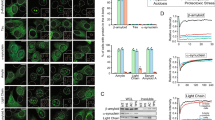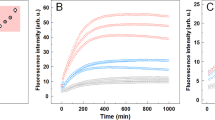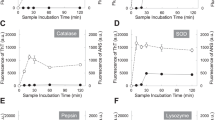Abstract
A range of human degenerative conditions, including Alzheimer's disease, light-chain amyloidosis and the spongiform encephalopathies, is associated with the deposition in tissue of proteinaceous aggregates known as amyloid fibrils or plaques. It has been shown previously that fibrillar aggregates that are closely similar to those associated with clinical amyloidoses can be formed in vitro from proteins not connected with these diseases, including the SH3 domain from bovine phosphatidyl-inositol-3′-kinase and the amino-terminal domain of the Escherichia coli HypF protein. Here we show that species formed early in the aggregation of these non-disease-associated proteins can be inherently highly cytotoxic. This finding provides added evidence that avoidance of protein aggregation is crucial for the preservation of biological function and suggests common features in the origins of this family of protein deposition diseases.
This is a preview of subscription content, access via your institution
Access options
Subscribe to this journal
Receive 51 print issues and online access
$199.00 per year
only $3.90 per issue
Buy this article
- Purchase on SpringerLink
- Instant access to full article PDF
Prices may be subject to local taxes which are calculated during checkout



Similar content being viewed by others
References
Kelly, J. W. The alternative conformations of amyloidogenic proteins and their multi-step assembly pathways. Curr. Opin. Struct. Biol. 8, 101–106 (1998).
Dobson, C. M. The structural basis of protein folding and its links with human disease. Phil. Trans. R. Soc. Lond. B 356, 133–145 (2001).
Lambert, M. P. et al. Diffusible, nonfibrillar ligands derived from Aβ-42 are potent central nervous system neurotoxins. Proc. Natl Acad. Sci. USA 95, 6448–6453 (1998).
Hartley, D. M. et al. Protofibrillar intermediates of amyloid beta-protein induce acute electrophysiological changes and progressive neurotoxicity in cortical neurons. J. Neurosci. 19, 8876–8884 (1999).
Pillot, T. et al. The nonfibrillar amyloid β-peptide induces apoptotic neuronal cell death: involvement of its C-terminal fusogenic domain. J. Neurochem. 73, 1626–1634 (1999).
Monji, A. et al. Inhibition of Aβ fibril formation and Aβ-induced cytotoxicity by senile plaque-associated proteins. Neurosci. Lett. 278, 81–84 (2000).
Walsh, D. M. et al. Amyloid β-protein fibrillogenesis. Structure and biological activity of protofibrillar intermediates. J. Biol. Chem. 274, 25945–25952 (1999).
Goldberg, M. S. & Lansbury, P. T. Jr Is there a cause-and-effect relationship between alpha-synuclein fibrillization and Parkinson's disease? Nature Cell. Biol. 2, E115–E119 (2000).
Conway, K. A. et al. Acceleration of oligomerization, not fibrillization, is a shared property of both alpha-synuclein mutations linked to early-onset Parkinson's disease: implications for pathogenesis and therapy. Proc. Natl Acad. Sci. USA 97, 571—576 (2000).
Zhu, Y. J., Lin, H. & Lal, R. Fresh and nonfibrillar amyloid beta protein(1–40) induces rapid cellular degeneration in aged human fibroblasts: evidence for A beta P-channel-mediated cellular toxicity. FASEB J. 14, 1244–1254 (2000).
Pepys, M. B. in Oxford Textbook of Medicine (eds Weatherall, D. J., Ledingham, J. G. & Warrel, D. A.) 3rd edn, 1512–1524 (Oxford Univ. Press, Oxford, 1995).
Lorenzo, A. & Yankner, B. A. β-amyloid neurotoxicity requires fibril formation and is inhibited by congo red. Proc. Natl Acad. Sci. USA 91, 12243–12247 (1994).
Thomas, T., Thomas, G., McLendon, C., Sutton, T. & Mullan, M. β-Amyloid-mediated vasoactivity and vascular endothelial damage. Nature 380, 168–171 (1996).
Clarke, G. et al. A one-hit model of cell death in inherited neuronal degenerations. Nature 406, 195–199 (2000).
Perutz, M. F. & Windle, A. H. Cause of neuronal death in neurodegenerative disease attributable to expansion of glutamine repeats. Nature 412, 143–144 (2001).
Glenner, G. G., Eanes, E. D., Bladen, H. A., Linke, R. P. & Termine, J. D. Beta-pleated sheet fibrils. A comparison of native amyloid with synthetic protein fibrils. J. Histochem. Cytochem. 22, 1141–1158 (1974).
Guijarro, J. I., Sunde, M., Jones, J. A., Campbell, I. D. & Dobson, C. M. Amyloid fibril formation by an SH3 domain. Proc. Natl Acad. Sci. USA 95, 4224–4228 (1998).
Chiti, F. et al. Designing conditions for in vitro formation of amyloid protofilaments and fibrils. Proc. Natl Acad. Sci. USA 96, 3590–3594 (1999).
Fandrich, M., Fletcher, M. A. & Dobson, C. M. Amyloid fibrils from muscle myoglobin. Nature 410, 165–166 (2001).
Chiti, F. et al. Solution conditions can promote formation of either amyloid protofilaments or mature fibrils from the HypF N-terminal domain. Protein Sci. 10, 2541–2547 (2001).
Sunde, M. & Blake, C. F. The structure of amyloid fibrils by electron microscopy and X-ray diffraction. Adv. Protein Chem. 50, 123–159 (1997).
Jimenez, J. L. et al. Cryo-electron microscopy structure of an SH3 amyloid fibril and model of the molecular packing. EMBO J. 18, 815–821 (1999).
Liu, Y., Peterson, D. A., Kimura, H. & Schubert, D. Mechanism of cellular 3-(4,5-dimethylthiazol-2-yl)-2,5-diphenyltetrazolium bromide (MTT) reduction. J. Neurochem. 69, 581–593 (1997).
Abe, K. & Saito, H. Amyloid beta protein inhibits cellular MTT reduction not by suppression of mitochondrial succinate dehydrogenase but by acceleration of MTT formazan exocytosis in cultured rat cortical astrocytes. Neurosci. Res. 31, 295–305 (1998).
Harper, J. D., Lieber, C. M. & Lansbury, P. T. Jr Atomic force microscopy imaging of seeded fibril formation and fibril branching by Alzheimer's disease amyloid-β protein. Chem. Biol. 4, 951–959 (1997).
Mendes Sousa, M., Cardoso, I., Fernandes, R., Guimaraes, A. & Saraiva, M. J. Deposition of transthyretin in early stages of familial amylodotic polyneuropathy. Evidence for toxicity of nonfibrillar aggregates. Am. J. Pathol. 159, 1993–2000 (2001).
Fezoui, Y. et al. A de novo designed helix-turn-helix peptide forms non-toxic amyloid fibrils. Nature Struct. Biol. 7, 1095–1099 (2000).
Hsia, A. Y. et al. Plaque-independent disruption of neural circuits in Alzheimer's disease mouse models. Proc. Natl Acad. Sci. USA 96, 3228–3233 (1999).
Zurdo, J., Guijarro, J. I. & Dobson, C. M. Preparation and characterisation of purified amyloid fibrils. J. Am. Chem. Soc. 123, 8141–8142 (2001).
Leroux, M. R. & Hartl, F. U. in Mechanisms of Protein Folding (ed. Pain, R. H.) 2nd edn, 364–405 (Oxford Univ. Press, Oxford, 1999).
Sherman, M. Y. & Goldberg, A. L. Cellular defenses against unfolded proteins: a cell biologist thinks about neurodegenerative diseases. Neuron 29, 15–32 (2001).
Li, L. R. & Lindquist, S. Creating a protein-based element of inheritance. Science 287, 661–664 (2000).
Booker, J. W. et al. Solution structure and ligand-binding site of the SH3 domain of the P85 alpha-subunit of phosphatidylinositil-3-kinase. Cell 73, 813–822 (1993).
Butterfield, D. A., Yatin, S. M., Varadarajan, S. & Koppal, T. Amyloid β-peptide-associated free radical oxidative stress, neurotoxicity and Alzheimer's disease. Methods Enzymol. 309, 746–768 (1999).
Acknowledgements
The work was supported by grants from the Italian MIUR (PRIN “Folding e Misfolding di Proteine) and the Italian Telethon Foundation. The research of C.M.D. is supported in part by a Programme Grant from the Wellcome Trust. F.C. is supported by a fellowship from the Italian Telethon Foundation.
Author information
Authors and Affiliations
Corresponding authors
Ethics declarations
Competing interests
The authors declare that they have no competing financial interests
Rights and permissions
About this article
Cite this article
Bucciantini, M., Giannoni, E., Chiti, F. et al. Inherent toxicity of aggregates implies a common mechanism for protein misfolding diseases. Nature 416, 507–511 (2002). https://doi.org/10.1038/416507a
Received:
Accepted:
Issue Date:
DOI: https://doi.org/10.1038/416507a



